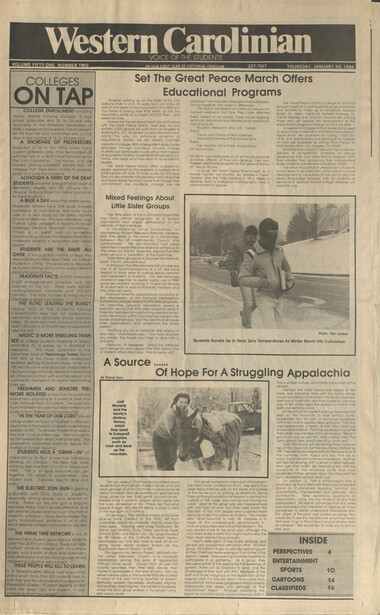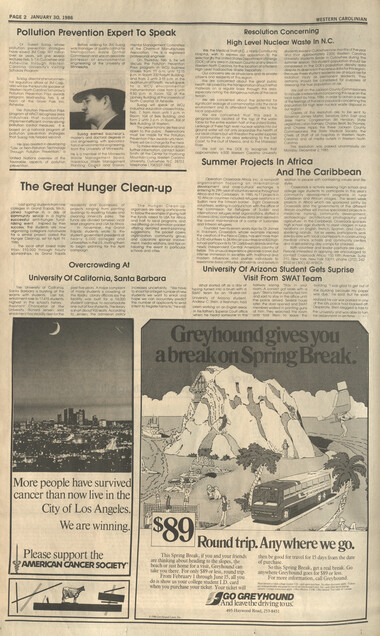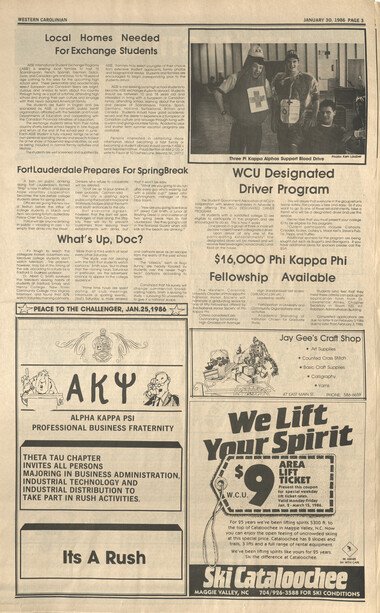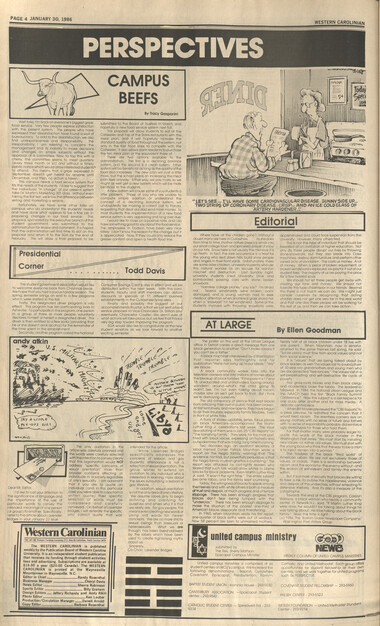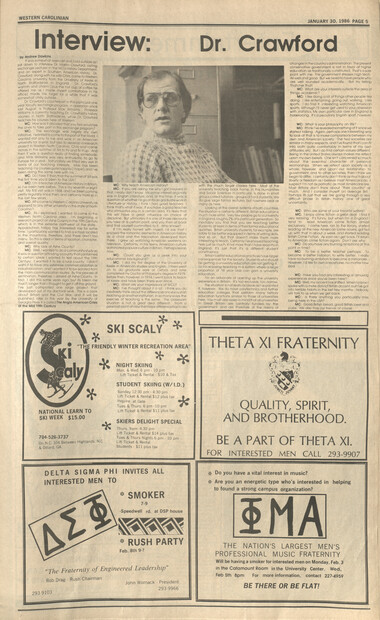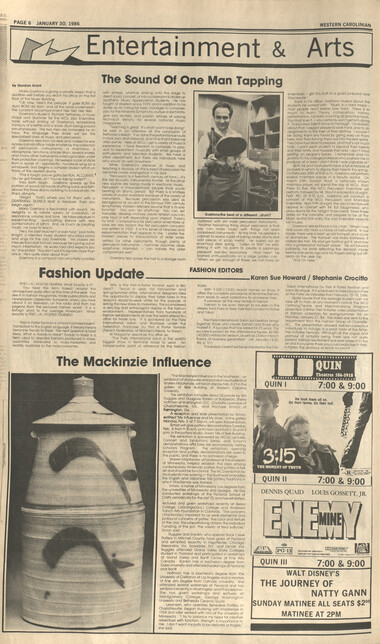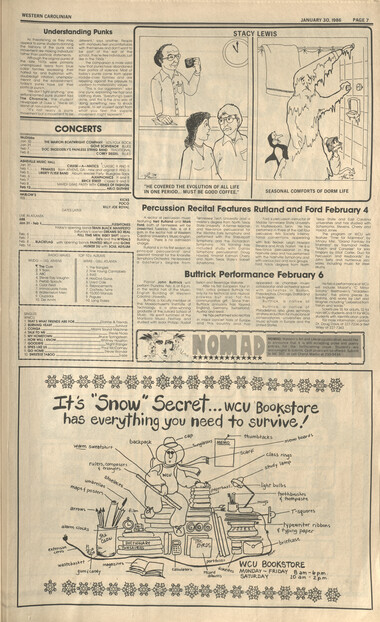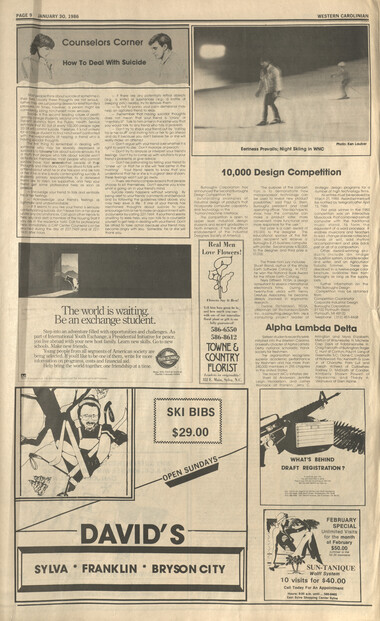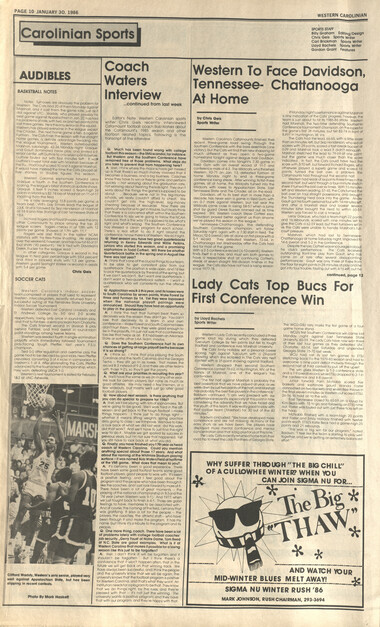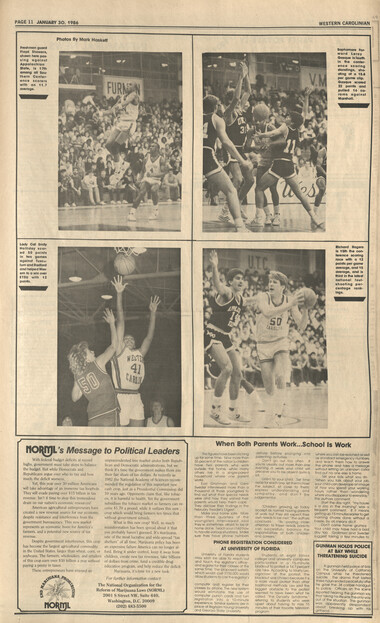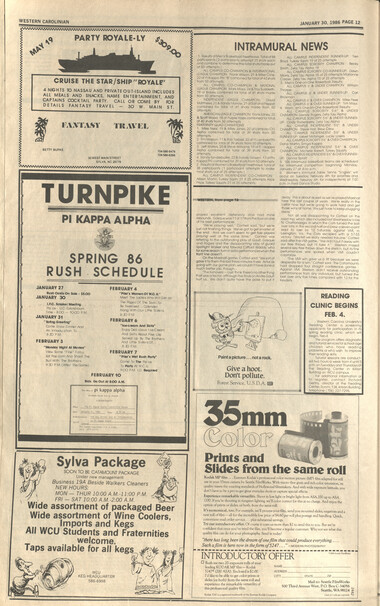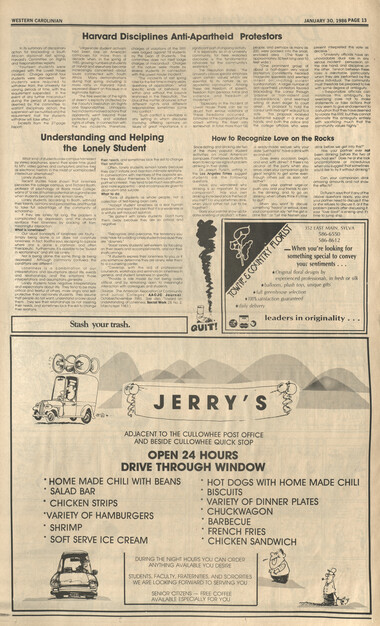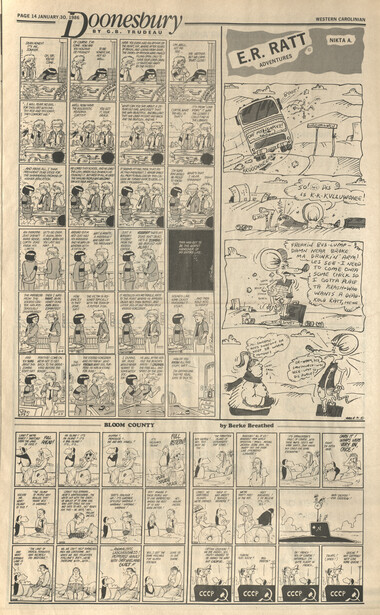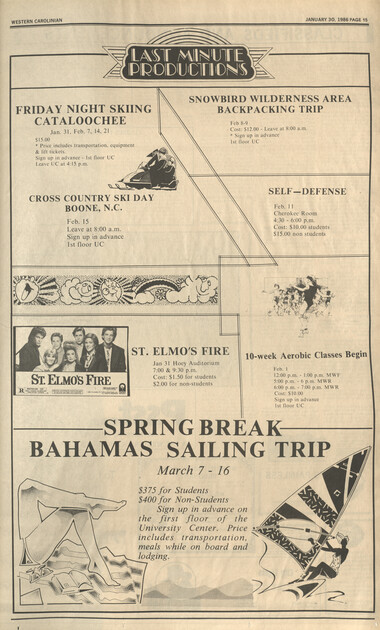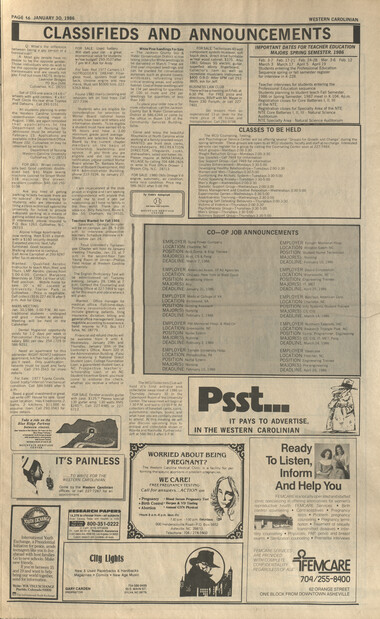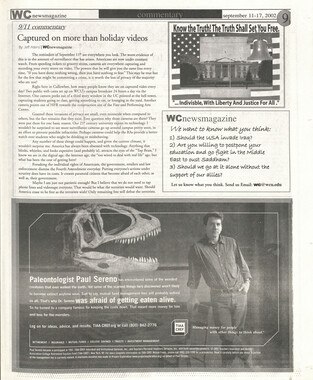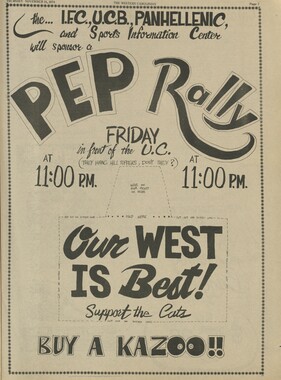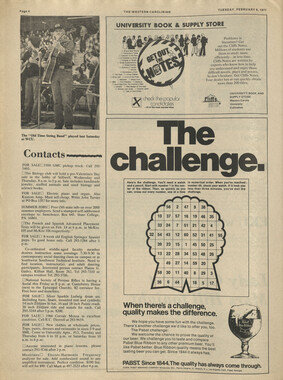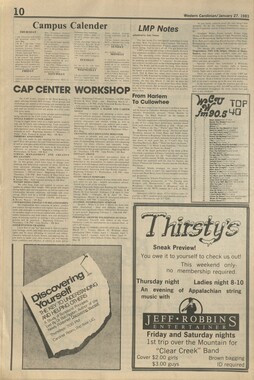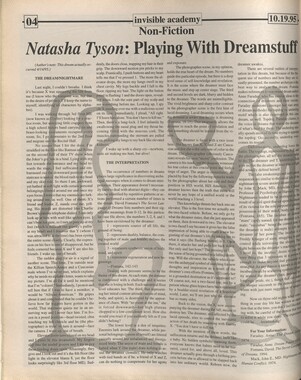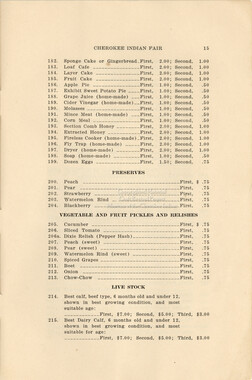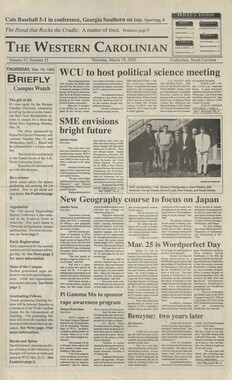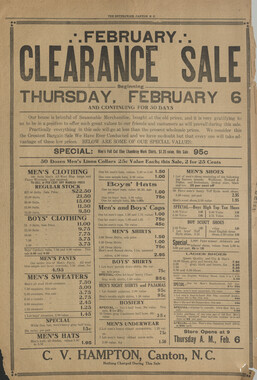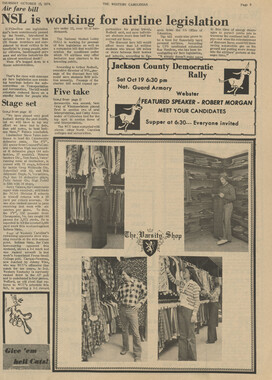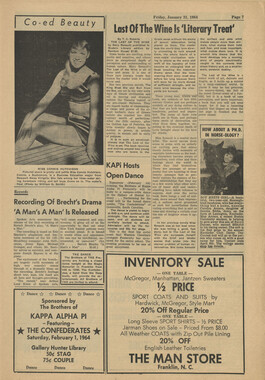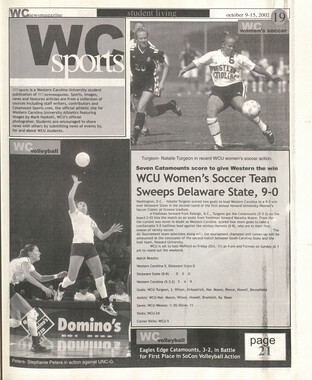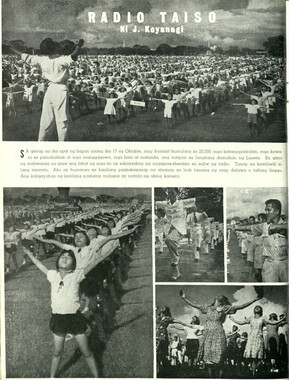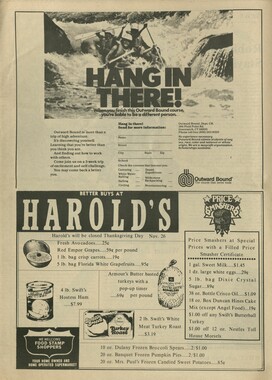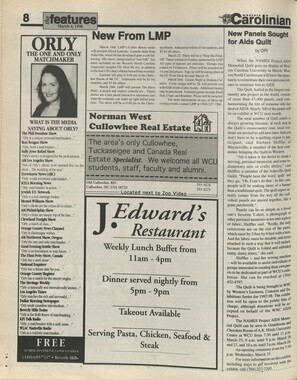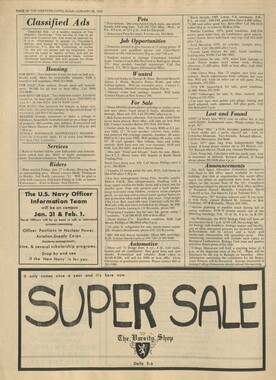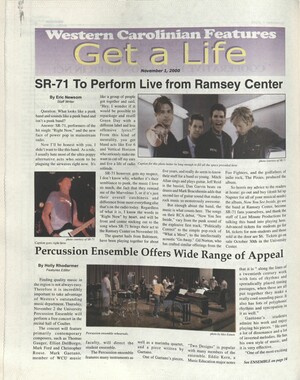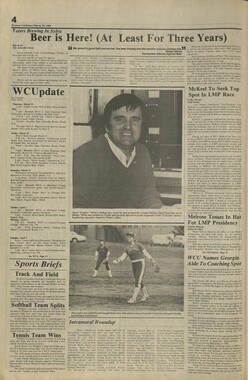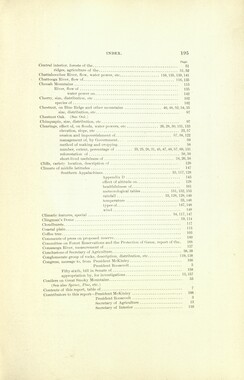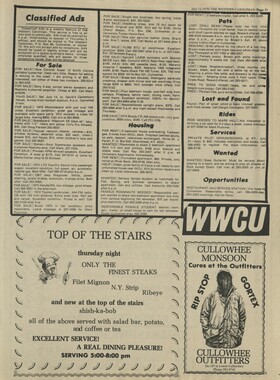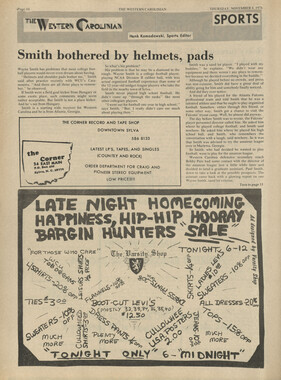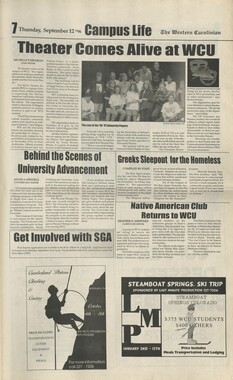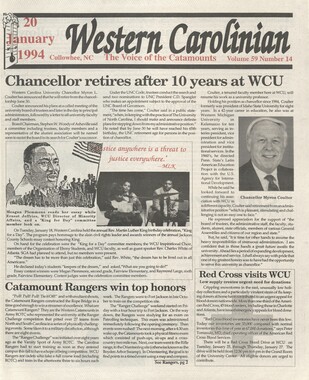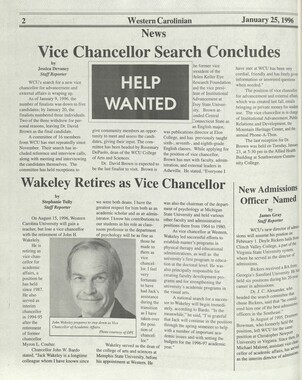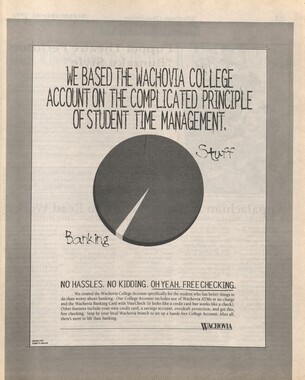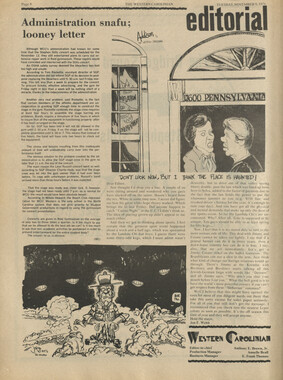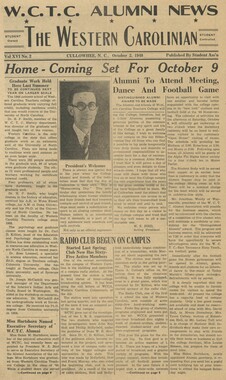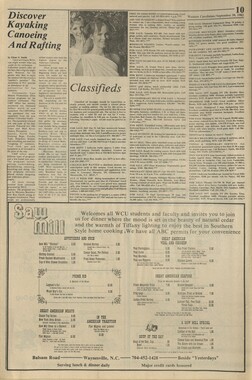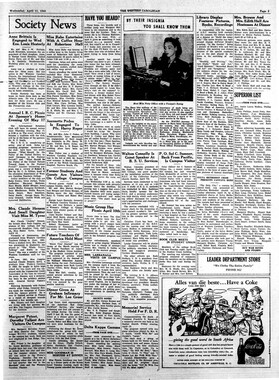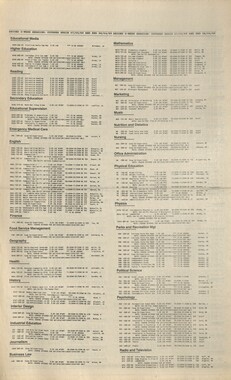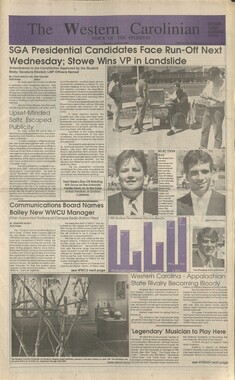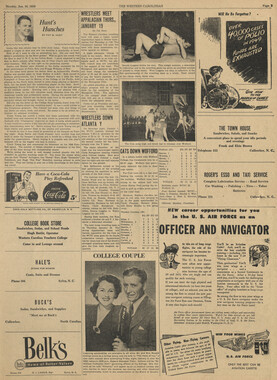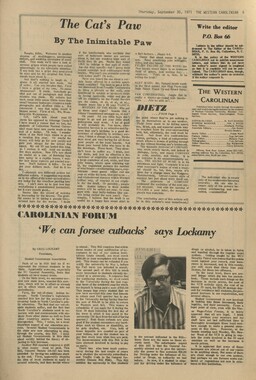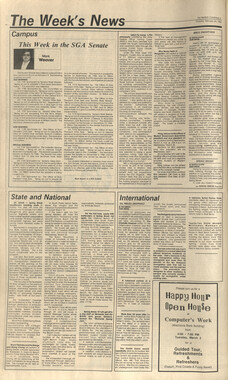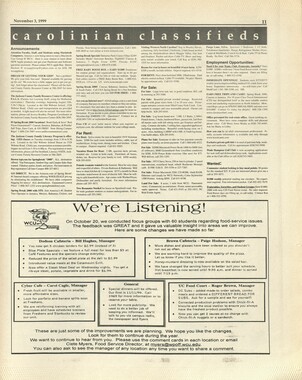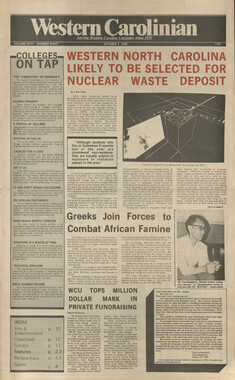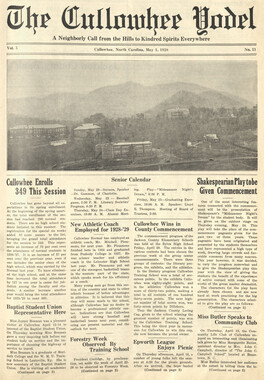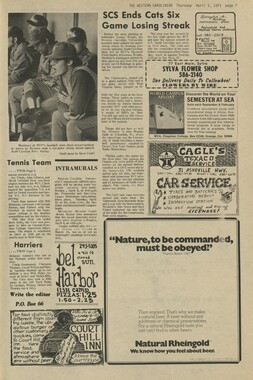Western Carolina University (1)
View all
- Western Carolina University Publications (2)
- Canton Champion Fibre Company (0)
- Cherokee Traditions (0)
- Civil War in Southern Appalachia (0)
- Craft Revival (0)
- Great Smoky Mountains - A Park for America (0)
- Highlights from Western Carolina University (0)
- Horace Kephart (0)
- Journeys Through Jackson (0)
- LGBTQIA+ Archive of Jackson County (0)
- Oral Histories of Western North Carolina (0)
- Picturing Appalachia (0)
- Stories of Mountain Folk (0)
- Travel Western North Carolina (0)
- Western Carolina University Fine Art Museum Vitreograph Collection (0)
- Western Carolina University Herbarium (0)
- Western Carolina University: Making Memories (0)
- Western Carolina University Restricted Electronic Theses and Dissertations (0)
- Western North Carolina Regional Maps (0)
- World War II in Southern Appalachia (0)
University of North Carolina Asheville (0)
View all
- Faces of Asheville (0)
- Forestry in Western North Carolina (0)
- Grove Park Inn Photograph Collection (0)
- Isaiah Rice Photograph Collection (0)
- Morse Family Chimney Rock Park Collection (0)
- Picturing Asheville and Western North Carolina (0)
- Western Carolina University (2)
- Allanstand Cottage Industries (0)
- Appalachian National Park Association (0)
- Bennett, Kelly, 1890-1974 (0)
- Berry, Walter (0)
- Brasstown Carvers (0)
- Cain, Doreyl Ammons (0)
- Carver, George Washington, 1864?-1943 (0)
- Cathey, Joseph, 1803-1874 (0)
- Champion Fibre Company (0)
- Champion Paper and Fibre Company (0)
- Cherokee Indian Fair Association (0)
- Cherokee Language Program (0)
- Crittenden, Lorraine (0)
- Crowe, Amanda (0)
- Edmonston, Thomas Benton, 1842-1907 (0)
- Ensley, A. L. (Abraham Lincoln), 1865-1948 (0)
- Fromer, Irving Rhodes, 1913-1994 (0)
- George Butz (BFS 1907) (0)
- Goodrich, Frances Louisa (0)
- Grant, George Alexander, 1891-1964 (0)
- Heard, Marian Gladys (0)
- Kephart, Calvin, 1883-1969 (0)
- Kephart, Horace, 1862-1931 (0)
- Kephart, Laura, 1862-1954 (0)
- Laney, Gideon Thomas, 1889-1976 (0)
- Masa, George, 1881-1933 (0)
- McElhinney, William Julian, 1896-1953 (0)
- Niggli, Josephina, 1910-1983 (0)
- North Carolina Park Commission (0)
- Osborne, Kezia Stradley (0)
- Owens, Samuel Robert, 1918-1995 (0)
- Penland Weavers and Potters (0)
- Rhodes, Judy (0)
- Roberts, Vivienne (0)
- Roth, Albert, 1890-1974 (0)
- Schenck, Carl Alwin, 1868-1955 (0)
- Sherrill's Photography Studio (0)
- Smith, Edward Clark (0)
- Southern Highland Handicraft Guild (0)
- Southern Highlanders, Inc. (0)
- Stalcup, Jesse Bryson (0)
- Stearns, I. K. (0)
- Thompson, James Edward, 1880-1976 (0)
- United States. Indian Arts and Crafts Board (0)
- USFS (0)
- Vance, Zebulon Baird, 1830-1894 (0)
- Weaver, Zebulon, 1872-1948 (0)
- Western Carolina College (0)
- Western Carolina Teachers College (0)
- Western Carolina University. Mountain Heritage Center (0)
- Whitman, Walt, 1819-1892 (0)
- Wilburn, Hiram Coleman, 1880-1967 (0)
- Williams, Isadora (0)
- Jackson County (N.C.) (2)
- Appalachian Region, Southern (0)
- Asheville (N.C.) (0)
- Avery County (N.C.) (0)
- Blount County (Tenn.) (0)
- Buncombe County (N.C.) (0)
- Cherokee County (N.C.) (0)
- Clay County (N.C.) (0)
- Graham County (N.C.) (0)
- Great Smoky Mountains National Park (N.C. and Tenn.) (0)
- Haywood County (N.C.) (0)
- Henderson County (N.C.) (0)
- Knox County (Tenn.) (0)
- Knoxville (Tenn.) (0)
- Lake Santeetlah (N.C.) (0)
- Macon County (N.C.) (0)
- Madison County (N.C.) (0)
- McDowell County (N.C.) (0)
- Mitchell County (N.C.) (0)
- Polk County (N.C.) (0)
- Qualla Boundary (0)
- Rutherford County (N.C.) (0)
- Swain County (N.C.) (0)
- Transylvania County (N.C.) (0)
- Watauga County (N.C.) (0)
- Waynesville (N.C.) (0)
- Yancey County (N.C.) (0)
- Newsletters (1)
- Publications (documents) (1)
- Aerial Photographs (0)
- Aerial Views (0)
- Albums (books) (0)
- Articles (0)
- Artifacts (object Genre) (0)
- Bibliographies (0)
- Biography (general Genre) (0)
- Cards (information Artifacts) (0)
- Clippings (information Artifacts) (0)
- Crafts (art Genres) (0)
- Depictions (visual Works) (0)
- Design Drawings (0)
- Drawings (visual Works) (0)
- Envelopes (0)
- Facsimiles (reproductions) (0)
- Fiction (general Genre) (0)
- Financial Records (0)
- Fliers (printed Matter) (0)
- Glass Plate Negatives (0)
- Guidebooks (0)
- Internegatives (0)
- Interviews (0)
- Land Surveys (0)
- Letters (correspondence) (0)
- Manuscripts (documents) (0)
- Maps (documents) (0)
- Memorandums (0)
- Minutes (administrative Records) (0)
- Negatives (photographs) (0)
- Newspapers (0)
- Occupation Currency (0)
- Paintings (visual Works) (0)
- Pen And Ink Drawings (0)
- Periodicals (0)
- Personal Narratives (0)
- Photographs (0)
- Plans (maps) (0)
- Poetry (0)
- Portraits (0)
- Postcards (0)
- Programs (documents) (0)
- Questionnaires (0)
- Scrapbooks (0)
- Sheet Music (0)
- Slides (photographs) (0)
- Songs (musical Compositions) (0)
- Sound Recordings (0)
- Specimens (0)
- Speeches (documents) (0)
- Text Messages (0)
- Tintypes (photographs) (0)
- Transcripts (0)
- Video Recordings (physical Artifacts) (0)
- Vitreographs (0)
- The Reporter, Western Carolina University (1)
- WCU Students Newspapers Collection (1)
- A.L. Ensley Collection (0)
- Appalachian Industrial School Records (0)
- Appalachian National Park Association Records (0)
- Axley-Meroney Collection (0)
- Bayard Wootten Photograph Collection (0)
- Bethel Rural Community Organization Collection (0)
- Blumer Collection (0)
- C.W. Slagle Collection (0)
- Canton Area Historical Museum (0)
- Carlos C. Campbell Collection (0)
- Cataloochee History Project (0)
- Cherokee Studies Collection (0)
- Daisy Dame Photograph Album (0)
- Daniel Boone VI Collection (0)
- Doris Ulmann Photograph Collection (0)
- Elizabeth H. Lasley Collection (0)
- Elizabeth Woolworth Szold Fleharty Collection (0)
- Frank Fry Collection (0)
- George Masa Collection (0)
- Gideon Laney Collection (0)
- Hazel Scarborough Collection (0)
- Hiram C. Wilburn Papers (0)
- Historic Photographs Collection (0)
- Horace Kephart Collection (0)
- Humbard Collection (0)
- Hunter and Weaver Families Collection (0)
- I. D. Blumenthal Collection (0)
- Isadora Williams Collection (0)
- Jesse Bryson Stalcup Collection (0)
- Jim Thompson Collection (0)
- John B. Battle Collection (0)
- John C. Campbell Folk School Records (0)
- John Parris Collection (0)
- Judaculla Rock project (0)
- Kelly Bennett Collection (0)
- Love Family Papers (0)
- Major Wiley Parris Civil War Letters (0)
- Map Collection (0)
- McFee-Misemer Civil War Letters (0)
- Mountain Heritage Center Collection (0)
- Norburn - Robertson - Thomson Families Collection (0)
- Pauline Hood Collection (0)
- Pre-Guild Collection (0)
- Qualla Arts and Crafts Mutual Collection (0)
- R.A. Romanes Collection (0)
- Rosser H. Taylor Collection (0)
- Samuel Robert Owens Collection (0)
- Sara Madison Collection (0)
- Sherrill Studio Photo Collection (0)
- Smoky Mountains Hiking Club Collection (0)
- Stories of Mountain Folk - Radio Programs (0)
- Venoy and Elizabeth Reed Collection (0)
- WCU Gender and Sexuality Oral History Project (0)
- WCU Mountain Heritage Center Oral Histories (0)
- WCU Oral History Collection - Mountain People, Mountain Lives (0)
- Western North Carolina Tomorrow Black Oral History Project (0)
- William Williams Stringfield Collection (0)
- Zebulon Weaver Collection (0)
- College student newspapers and periodicals (1)
- African Americans (0)
- Appalachian Trail (0)
- Artisans (0)
- Cherokee art (0)
- Cherokee artists -- North Carolina (0)
- Cherokee language (0)
- Cherokee pottery (0)
- Cherokee women (0)
- Church buildings (0)
- Civilian Conservation Corps (U.S.) (0)
- Dams (0)
- Dance (0)
- Education (0)
- Floods (0)
- Folk music (0)
- Forced removal, 1813-1903 (0)
- Forest conservation (0)
- Forests and forestry (0)
- Gender nonconformity (0)
- Great Smoky Mountains National Park (N.C. and Tenn.) (0)
- Hunting (0)
- Landscape photography (0)
- Logging (0)
- Maps (0)
- Mines and mineral resources (0)
- North Carolina -- Maps (0)
- Paper industry (0)
- Postcards (0)
- Pottery (0)
- Railroad trains (0)
- Rural electrification -- North Carolina, Western (0)
- School integration -- Southern States (0)
- Segregation -- North Carolina, Western (0)
- Slavery (0)
- Sports (0)
- Storytelling (0)
- Waterfalls -- Great Smoky Mountains (N.C. and Tenn.) (0)
- Weaving -- Appalachian Region, Southern (0)
- Wood-carving -- Appalachian Region, Southern (0)
- World War, 1939-1945 (0)
- Text (2)
- MovingImage (0)
- Sound (0)
- StillImage (0)
Western Carolinian Volume 51 Number 02
Item
Item’s are ‘child’ level descriptions to ‘parent’ objects, (e.g. one page of a whole book).
-
-
Wfesi ter n Carol • 1 I l f\ j 1 1 VOICE OF THE STUDENTS VOLUME FIFTY-ONE NUMBE RTWO IN OU1LE1RST IMROf EDITORIAL FREEDOM 227-7267 THURSDAY. JANUARY 30, 1986 COLLEGES ON TAP COLLEGE ENROLLMENT is holding steady despite shrinking numbers of high school graduates and 18- to 24-year olds, according to the American Association of State Colleges and Universities. Fall enrollment 'fell 1% from last year, contrasted with a 2.6% drop in the number of 18- to 24-year olds. A SHORTAGE OF PROFESSORS, expected to hit in the 1990s when many current professors retire, may be headed off with the help of a $4,75 million fund set up by the Ford Foundation. The money is to b$ divided among successful bidders from 39 colleges that have been invited to propose projects to solve the problems. ALTHOUGH A THIRD OF THE DEAF STUDENTS who enter college intend to earn a Bachelor's degree, only 5% actually do. (Source: National Project on Higher Education for Deaf Students.) A BEER A DAY keeps the doctor away: Moderate drinkers have 25% fewer illnesses compared to non-drinkers and hard liquor users in a new study by the Johns Hopkins School of Medicine. "It is very interesting/' says Thomas Turner, president of Hopkins Alcoholic Beverage Medical Research Foundation. "There is a great deal of evidence accumulating all over the Western World that moderate drinking is associated with better health." STUDENTS ARE THE SAME ALL OVER: In the past four months, at least nine demonstrations have been held by college students in China. The issues are as disparate as nuclear testing, birth control, lousy cafeteria ^foodand early curfews. FRATERNITY FACTS In 1985, fherewere 5,618 undergraduate chapters and 350 colonies in the U.S.' There were 300,000 undergraduate members and 100,000 initiates. The total number of living alumni members is nearly four million. THE BLIND LEADING THE BLIND? Nearly half of the students taking Connecticut's new test for prospective elementary and secondary school teachers failed. Students who had scored a total of at least 1,000 points on the SAT are not required to take the test. MUSIC IS MORE THRILLING THAN SEX to college students majoring in music, according to a survey by a Stanford U. researcher. The study, published in the December issue of Psychology Today, found that 86% of the music majors questioned reported getting thrills from music, while only 70% felt the same way about sex. Respondents also found a good movie, beauty in nature and art, physical contact with another person and a climactic moment in an opera more thrilling than sex. FRESHMEN AND SENIORS FEEL MORE ISOLATED in class than do juniors and sophomores, according to a survey of more than 3,000 Michigan State u\ students. The survey also found that freshmen were most likely to interact with students from different racial backgrounds. "IN THE YEAR OF OUR LORD"shouid not be written on the U. of Southern California's diplomas, in the opinion of Jewish students and leaders at USC. The phrase "implies that Jesus is the lord," a local Rabbi says. "Many students do not believe that Jesus Christ is the lord." The graduation committee plans to discuss the matter at its next meeting. STUDENTS HELD A "DRINK-IN" at Columbia U. to flout a new rule forbidding drinking on campus. The New York state drinking age,rose from 19 to 21 in December, 1985. "This is an issue everyone can get together on, liberal or conservative," one student said. "Everyone likes to drink and party." THE ELECTRIC STUN GUN is gaining popularity with Ohio State U. students, especially among women, as a deterrent to crime. Police say the stun gun is popular because Mace hasn't proved effective, and self-defense classes take too much time from a student's schedule. Nova Technologies, the gun's manufacturer, promotes if as a non- lethal defense weapon that is easy to use and carry. THE PRIME TIME NETWORK is a u of Nevada-Reno student group helping students older than 25 fit in on campus, The group helps "mature" students network with on-campus groups, runs a series of study skills workshops, and offers sociai and discussion groups aimed overeating a positive self-concept. THESE PEOPLE WILL KILL TO LEARN: U. of Massachusetts officials had to summop police when more than 800 students tried to push their way into an auditorium to register for intersession classes. "It didn't depend on first come, first serve," said one student, "it was Set The Great Peace March Offers Educational Programs Imagine: waking up on the edge of the Zion National Park in Utah. It's early April, and snow still rests on the peaks of the mountains in the distance. You follow a flowing river that winds up into the mountains, climb to a height of 2,200 feet - and break for class. Scenes like this will repeat each day on the road with the Great Peace March. Next year, for nine months, 5,000 people will walk from Los Angeles to Washington, DC. for global nuclear disarmamnent. Along the way, an extensive program of educational studies will be offered marchers currently in college. With independent study credits arranged through individual schools, college students can participate in one of the most massive and powerful citizens movements for peace in U.S. history, and apply what they learn to an academic degree. The Great Peace March offers a person-to- person approach to the problem of nuclear arms. 5,000 people will walk 15 miles a day for 255 days. They will demonstrate to those they meet in the cities and towns along the March route that through their commitment and sacrifece, change can be Mixed Feelings About Little Sister Groups The "little sisters" of the U. of Florida's fraternities now have official recognition as a student organization and equal participation in the selection of their members. A membership drive committee, its membership divided between fraternity members and little sisters, is the result of a compromise between the UF Interfraternity Council and administration. The administration had asked fraternities to leave little sister selection entirely up to little sisters, but the IFC objected, arguing that little sisters are only a "subsidiary" of the fraternities. "Little sisters groups exist because the fraternity exists," the IFC president says. A change in the little sister selection process was one of 49 recommendations of a UF task force created to study ways of curbing sexual coercion and harassment of students. The task force was created in response to public outcry over a 1983 group-sex incident involving a 17-year-old female UF student and at least six fraternity members at a little sister rush party. National fraternity organizations, according to Bob Marchesani of the National Interfraternity Conference, strongly object to little sister programs. The Fraternities Executive Association passed a resolution saying that little sister programs distract fraternity members from performing essential duties, invite disharmony within the chapters, weaken the bonds of brotherhood, "blur the identity of all Greek letter organizations and undermine the entire system." "Anything you do to formalize little sisters is a bad idea," Marchesani says. "The more structure you create, the longer you have to deal with a problem." Obviously, UF disagrees. "Since the nationals don't recognize and support (the little sisters)," the UF student affairs dean says, "the university will." achieved. The marchers' message is that individuals, acting together, can make a difference. The March will present an historical overview on nuclear weapons and how they have affected every aspect of our society. There will be ongoing seminars, discussions and detailed study sessions on topicssuch as: Nuclear Weapons ana U.S. Foreign Policy Theory and Politics of Non-Violence Historical Overview of the Nuclear Arms Race The Nuclear Arms Race: Implications for Democracy Students can participate in all of the educational activities offered, or they can develop their own independent study program on the general theme of "Peace Studies." To study the Great Peace March itself, as a movile human community, an interdiscn Public Opinion and the 1986 Elections"). All it takes to develop such a curriculum is imagination and a commitment to peace. The Great Peace March's College on Foot has brought together a distinguished group of scholars and activists to make up its Academic Advisory Board. Dr. Helen Caldicott, Randall Forsberg, Dr. Daniel Ellsberg and Norman Cousins are among those who will oversee the development of the educational programs College on Foot will offer. To register for College on Foot, students first need to apply to be a marcher in the Great Peace March. Applications are available by calling 1-800-453- 1234, and applications and brochures for College on Foot are available by writing PRO—Peace at 8150 Beverly Blvd., Los Angeles, CA 90048. Students then need to meet with the academic advisors or sympathetic professors to discuss developing their own educational program. With their advisors then sponsoring their independent study, students can receive academic credit. • The Great PeaceMarchoffersawayforstudents to be heard. It will carry the call for global nuclear disarmament to the leaders of this country and the world. Knowledge, brought forth by students of peace and applied toward college degrees, will lead the way. Photo : Ken Lauber Students Bundle Up In Near Zero Temperatures As Winter Storm Hits Cullowhee A Source by Elaine Tola Of Hope For A Struggling Appalachia Judi * -S xm *#* Morairty and the M i family's donkey, Nancy, 1 " BaS Kit BKi •» which {LjKL they used ^^^^^M to transport IH^^^iir^^^ supplies such as coal and food up the id* ■ mountain. ~*M 1 .- ^y» i 11 The last week of Christmas break offered seven students from the' Catholic Student Center at WCU a small glimpse of what Christmas could really be all about. For seven days we worked with great people living under far less than great circumstances. People living in poverty, poverty which yields only the bare necessities of life. These are the same people though, who are still willing to share a meal in the true spirit of Christmas. On January 6,1986 a stationwagon and a small pick-up truck (loaded to the limit) left from Cullowhee bound for Jonesville, Virginia some 250 miles away. Traveling were Greg McAlindon, Bill Mehle, Judi Moriarfy, Craig Cortez, Lea Anne Alger, Richard Griffin and Elaine Tola. Our group headed by Bill Mehle of the Catholic Student Center, volunteered our time and tools to work on an on going home repair project known as the Appalachia Service Project, or ASP. The Appalachia Service Project, affiliated with the United Methodist Church, is a non-profit organization serving the poor of Appalachia through home repair. Groups from all over the country volunteer their time and donate their money to participate in this work of mercy. ASP has eleven centers open in the summer that are located in some of the coal mining counties of eastern Kentucky, eastern Tennessee, southwest Virginia, and southern West Virginia. The center in Jonesville, where the WCU grorjp worked, is the project's only year round center. The group worked with a new part of the project, the New Home Construction Plan. They spent their days doing finishing work on the inside and outside of the house such as putting up sheetrock, laying f loori ng, laying foundation for the pore h, staini ng the outside of the house, and cutting and moving fire wood. Most of the group was very inexperienced with this type of work, but they were under the direction of two staff people who coached them along and had the patience of saints. The leaders were never reluctant to help "fix" mistakes or **~> laugh at the unexplainable predicaments tl novices always seemed to find themselves in. The was always a job to be done and, although the volunteers worked better than eight hours a day, the ; days never seemed long enough. Nights were spent at the center relaxing, and people got acquainted with each other. Another group, from Baton Ruge, La. was also spending part of their Christmas break working on the homes of the , region's needy. Every evening all came together to participate in a gathering. As a group, they discussed some of the reasons for the existence of poverty, there call as Christians to serve, and the challenges of their work with ASP. Members of the staff and those indiginous to the region told of the legends and the folk-lore which have come from Appalachia. Astheweekprogressedmanycameto appreciate the deep, rich heritage of the Appalachian region. Although classifying this I region as a world of its own would not be accurate, it - has a unique culture, which reflects-the heart of the people. Perhaps the most memorable aspect of the week was spending time with the family whose house was being constructed. The family's openess, welcoming hospitality and their simple but creative way of life challenged the workers to match their spirit ana determination. At the end of the week the group made one last hike up the mountain to their family's home, accessable only by foot, to exchange goodbyes with them and to express deep gratitude. That day was experienced a depth of faith that none had encountered before. Nothing expressed this better than when one member of the family said, "Weain't got much, but we got life", and another said, "The Lord's gonna take good care of us, you'll see." Soon the family will be leaving their home on top of this mountain for the new home, finished by ASP. They will be leaving reluctantly because of all of the memories, both happy and sad, that are so much a part of their home and themselves. But they will also be leaving with a sense of relief because their age and health are becoming less and less conducive to the enormous climb they must undertake if they venture down the mountain for such necessities as food and coal. On January 12, 1986 a stationwagon and a small pick-up truck, filled with tired students headed back to Cullowhee leaving behind an economically impoverished but spiritually rich community. New questions, questions of responsibility, came into the minds of all who had participated. Bill Mehle, convinced that this week was successful and important in helping all those concerned to better understand themselves and the plight of the poor, was quoted as saying, "We would like to see this trip become an annual event and open it up to the United Campus Ministry here on campus." We would like to invite you to join us next year. INSIDE PERSPECTIVES 4 ENTERTAINMENT SPORTS 10 CARTOONS 14 CLASSIFIEDS 46
Object
Object’s are ‘parent’ level descriptions to ‘children’ items, (e.g. a book with pages).
-
The Western Carolinian is Western Carolina University's student-run newspaper. The paper was published as the Cullowhee Yodel from 1924 to 1931 before changing its name to The Western Carolinian in 1933.
-
